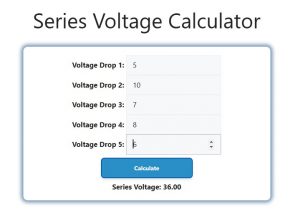About Series Voltage Calculator (Formula)
The Series Voltage Calculator is an essential tool for electrical engineers, technicians, and students dealing with series circuits. In these circuits, the total voltage is not simply provided by a single power source but is a combination of the voltage drops across each component. This calculator streamlines the process of calculating the total voltage, enabling users to ensure that their circuits are functioning properly and efficiently.
Formula
To calculate the total voltage in a series circuit, the following formula is used: Vseries = SUM(Vd), where Vd represents the individual voltage drops across each component in the circuit. In this case, the voltage drops are identified as Voltage Drop 1 (V1), Voltage Drop 2 (V2), Voltage Drop 3 (V3), Voltage Drop 4 (V4), and Voltage Drop 5 (V5).
How to Use
Using the Series Voltage Calculator is straightforward. Follow these steps:
- Input Voltage Drops: Enter the voltage drops for each of the five components in the provided input fields.
- Calculate Total Voltage: Click the “Calculate” button to sum the voltage drops.
- View Results: The total voltage will be displayed in the designated output field.
Example
Suppose you have the following voltage drops in a series circuit:
- Voltage Drop 1 (V1): 5V
- Voltage Drop 2 (V2): 10V
- Voltage Drop 3 (V3): 7V
- Voltage Drop 4 (V4): 8V
- Voltage Drop 5 (V5): 6V
By inputting these values into the calculator:
- Vseries = V1 + V2 + V3 + V4 + V5
- Vseries = 5V + 10V + 7V + 8V + 6V = 36V
The total voltage across the series circuit would be 36V.

FAQs
1. What is a series circuit?
A series circuit is an electrical circuit where components are connected in a single path, so the same current flows through all components.
2. How does voltage behave in a series circuit?
In a series circuit, the total voltage is the sum of the voltages across each individual component.
3. Why is calculating total voltage important?
It ensures that the circuit operates within the necessary voltage range and helps diagnose potential issues.
4. Can this calculator be used for any number of voltage drops?
This version is designed for five voltage drops, but it can be modified for more or fewer components.
5. What is the significance of Vseries?
Vseries indicates the total voltage supplied to the series circuit, which is critical for proper operation.
6. What if one of the voltage drops is zero?
A zero voltage drop indicates that the component has no resistance, but the total voltage will still be the sum of the other voltage drops.
7. Can I use this calculator for AC circuits?
Yes, but ensure you account for any phase shifts that may occur in AC circuits.
8. What tools can I use to measure voltage drops?
A multimeter is commonly used to measure voltage drops across components.
9. What if my total voltage is higher than expected?
Check for measurement errors or faulty components that may be causing higher voltage readings.
10. How does the total voltage affect circuit performance?
If the total voltage exceeds the rating of any component, it can lead to overheating or failure.
11. Can I use the calculator for resistors only?
No, it can be used for any components where voltage drops are present, such as capacitors or inductors.
12. What are typical voltage drop values for common components?
Values vary widely depending on the component and its specifications.
13. Is there a limit to the input voltage values?
While there is no specific limit, always use realistic values based on your circuit’s specifications.
14. How can I verify the results from the calculator?
You can use a multimeter to measure the voltage across components directly.
15. What happens if I enter a negative voltage drop?
Negative values could indicate a reversal in potential, which may not be typical for passive components.
16. How do I know if my series circuit is functioning correctly?
Measuring and confirming expected voltage drops can help verify circuit functionality.
17. Can the calculator help with troubleshooting?
Yes, it can aid in identifying discrepancies in expected voltage values.
18. Are there safety considerations when working with series circuits?
Always ensure circuits are powered down before making adjustments and use appropriate safety gear.
19. How do I interpret the voltage drop results?
Compare the calculated total voltage to your circuit’s power supply to ensure compatibility.
20. What if I have additional questions about series circuits?
Consult textbooks, online resources, or seek help from experienced professionals.
Conclusion
The Series Voltage Calculator is an invaluable tool for anyone working with series circuits. By using the formula Vseries = SUM(Vd), users can easily calculate the total voltage across multiple components. This calculator not only simplifies the voltage calculation process but also enhances understanding of series circuit behavior, ensuring efficient and effective circuit design and troubleshooting.